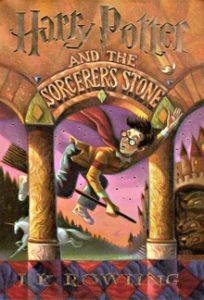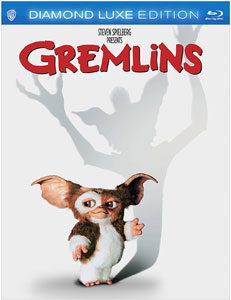On this 20th anniversary of the day J.K. Rowling introduced Harry Potter to the world, I take a look back at “Harry Potter and the Sorcerer’s Stone.” I’ll have posts on all the books and movies throughout this anniversary year.
I recently found hardcovers of “Harry Potter” books 1, 4, 5, 6 and 7 for a buck apiece at the local library, leaving me no more excuses for avoiding a “Potter” re-read. But as I neared the end, I learned something you should always have on hand when reading Book 1, and that’s Book 2.
Somewhat ridiculously, I thought re-reading “Harry Potter and the Sorcerer’s Stone” — released on June 26, 1997, in England and more than a year later in the U.S. – would be a slog. I remembered this as being a kids’ book, with things becoming more adult-friendly later. But I really engaged with “Sorcerer’s Stone” this time.
It’s no secret that J.K. Rowling made young-adult fiction palatable to the masses, while also inspiring loads of her target audience to love reading. But what was her secret? I think it’s because she writes from the perspective of 11-year-old Harry, and Harry is a reasonably sharp lad. She doesn’t write TO an 11-year-old’s POV, but FROM an 11-year-old’s POV. I suspect if she ever wrote this same story from the perspective of, say, Dumbledore or McGonagall, it would immediately – and correctly — be labeled an adult novel. (By the way, wouldn’t it be interesting if she did an “Ender’s Shadow”-style take on the “Potter” series from the perspective of another character?)
Harry, Ron and Hermione have all the schoolkid fears of being bullied, laughed at, ignored or expelled, reminding us of how everything seemed scary at that age. On the flip side, Harry makes friends (first Ron, then Hermione) at Hogwarts in the down time between being terrified – almost accidentally, as these things often happen. At the end of Chapter 10, after the trio fells a large troll, Rowling writes:
From that moment on, Hermione Granger became their friend. There are some things you can’t share without ending up liking each other, and knocking out a 12-foot mountain troll is one of them.
Friend-making doesn’t come totally by accident, though, as Harry points out to Malfoy that he’s quite capable of deciding for himself who is friend material. Additionally, Harry is experiencing the reality of magic (now known as “the Wizarding World,” although the phrase doesn’t appear in this book) for the first time. Being a kid, he has a sense of wonder; seeing it through his eyes, our inner 11-year-old is awoken as well.
Rowling has a beautiful imagination. We learn about Quidditch, the Mirror of Erised, the Invisibility Cloak and the Forbidden Forest. “Sorcerer’s Stone” has a palpable sense of place, from the warmth of the Gryffindor common room with its fireplace and lush armchairs to the chills of the dungeon classroom where Snape teaches Potions.
Rowling, 31 when “Sorcerer’s Stone” came out, never lost her sense of “What if?,” as we can see when Dumbledore uses magic to capture all the balls of light in the streetlamps of Privet Drive, making the neighborhood dark. Or when Harry and Ron chow down on Chocolate Frogs, which jump around like frogs but are actually non-living chocolate candies. Or the fact that food appears and disappears in the Great Hall during every feast. There’s no real-world logistical problem that can’t be solved by magic.
Yet “Sorcerer’s Stone” is wholly about encountering and solving problems — sometimes in a truly scary way. I wouldn’t go into the Forbidden Forest described by Rowling, and I’m much older than 11. But sometimes the problems – although real enough – are funny, and this is another page-turning aspect of the author’s work. Hagrid considers Norbert the Norwegian Ridgeback to be a lovable little dragon, but he has to constantly patch up his dragon-inflicted injuries. Neville’s potion goes so wrong that he melts a pewter cauldron. Rowling delivers a few movie-style zingers, like when Hermione worries they could be killed – “or worse, expelled!” And when Ron tells Hermione to fight off a deadly plant with fire and she frets that there’s no wood around, Ron has to remind her she’s a witch.
But mostly, Rowling is at home in the world of books – indeed, “Sorcerer’s Stone” makes mention of many tomes, including Newt Scamander’s “Fantastic Beasts and Where to Find Them” — and she dodges clichés better than most YA scribes. At the House Cup ceremony, it’s not a shock that Dumbledore awards last-minute points to Gryffindor, putting it ahead of Slytherin. But it is a nice twist that Neville earns the points that put Gryffindor over the top.
Rowling seems to love all her characters for their humanity, but she isn’t afraid to acknowledge that the world includes awful people, and in this opening book they are represented by the Dursleys. Voldemort tried to kill Harry as a baby, Snape makes every moment in Potions class a living hell, and Malfoy is the dictionary definition of a bully, but the Dursleys strike me as the true villains of the piece. I’d honestly argue that they are scarier than Voldemort, because death is less scary than torture. Their treatment of Harry – housing him in a closet under the stairs till he’s 11 – is abominable. This is another way Rowling puts us in Harry’s shoes: When he can’t wait to get to Hogwarts – and away from the Dursleys — at the start of every book, we’re right there with him.
While “Sorcerer’s Stone” is perfect in many ways, I can level some criticisms if I really try. The biggest logic hole is that it seems the Wizarding World should be widely known by the Muggle World in the late 20th century, when the “Potter” saga takes place. For example, Hermione’s Muggle parents are well aware that they are sending their daughter to a magic school, and you’d think they’d mention this to other people. While it’s not common for a child of two Muggles to have magic abilities, it’s not unheard of; extrapolate this back through the ages, and it’s clear that word should have spread through “normal” civilization. More mundanely, people should see wizards walking through the wall to their train platform every day. Colloquially, magic is the opposite of science, but in the world of “Harry Potter,” magic can be studied and catalogued via the scientific method; magic follows consistent laws.
Thematically, though, it works. The Dursleys stand in for the Muggle world’s POV (although most of us are not as aggressively anti-magic, of course): Magic is not “normal,” and therefore it is something to be shunned from existence. It’s a legitimate commentary on conformity. Throw in an occasional reference to the mass-knowledge problem – such as wizards using forgetfulness spells on Muggles who see a dragon – and there’s just enough verisimilitude that I’ll let Rowling slide. (As the saga goes forward, Rowling further bolsters her case that magic could stay hidden from Muggles, and I am interested to encounter those examples again.)
Rowling’s note-taking is legendary, and it’s remarkable how the “Potter” world feels fully formed in Book 1. There are a couple exceptions; she merely writes “the village” instead of “Hogsmeade.” And I wonder if she always knew it would be a seven-book saga chronicling seven years of school; the highest-level student mentioned here is a fifth year.
Those aren’t serious criticisms, though – and besides, I wouldn’t want the whole world spelled out in one info-dump; I am excited to keep going with this re-read. Although I have to count on the post office instead of Hedwig the owl, “Chamber of Secrets” is on its way to my mailbox.
Movie review: “Sorcerer’s Stone”
Next book: “Chamber of Secrets”


